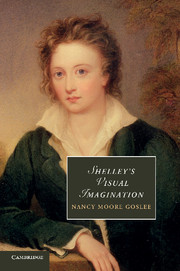Book contents
- Frontmatter
- Contents
- List of illustrations
- Acknowledgments
- 1 Introduction: text and figure
- 2 Mab's metamorphoses
- 3 “Hymn to Intellectual Beauty”: visual texts, invisible figure
- 4 “Clear elemental shapes”: communicating Greek liberty in Laon and Cythna
- 5 Anarchy's textual progress: representing liberty
- 6 Refiguring genre in Shelley's “Ode to Liberty”
- 7 Dispersoning Emily: drafting as plot in Epipsychidion
- 8 “Compelling / All new successions”: death and the poet's figurations in Adonais
- 9 The Triumph of Life: figure, history, and inscription
- Notes
- Bibliography
- Index
- CAMBRIDGE STUDIES IN ROMANTICISM
6 - Refiguring genre in Shelley's “Ode to Liberty”
Published online by Cambridge University Press: 05 March 2014
- Frontmatter
- Contents
- List of illustrations
- Acknowledgments
- 1 Introduction: text and figure
- 2 Mab's metamorphoses
- 3 “Hymn to Intellectual Beauty”: visual texts, invisible figure
- 4 “Clear elemental shapes”: communicating Greek liberty in Laon and Cythna
- 5 Anarchy's textual progress: representing liberty
- 6 Refiguring genre in Shelley's “Ode to Liberty”
- 7 Dispersoning Emily: drafting as plot in Epipsychidion
- 8 “Compelling / All new successions”: death and the poet's figurations in Adonais
- 9 The Triumph of Life: figure, history, and inscription
- Notes
- Bibliography
- Index
- CAMBRIDGE STUDIES IN ROMANTICISM
Summary
In contrast to the more traditional iconographic methods of The Mask of Anarchy, the “Ode to Liberty” at first seems to return to the sort of iconoclasm Shelley developed for his “Hymn to Intellectual Beauty” in 1816. Like Intellectual Beauty, the elusive and barely humanized power evoked in the “Hymn,” Liberty in his 1820 Ode has almost no physical or anthropomorphic characteristics even when she is reported present. Though both personifications balance between concept and quasi-human figure brought alive through the poet's apostrophe, this lack of visual representation is particularly striking in the ode. Once Shelley had decided to write an “Ode to Liberty” in the spring of 1820, his address to that figure would have called up to his readers the very material history of the preceding three decades, not only the acting-out of revolutionary freedom in France, interpreted by the anti-Jacobins as “Anarchy,” but also the concrete, visual, and plastic representations of Liberty as a human figure, usually a woman, surrounded by emblems of her power.
For though James Thomson in the mid eighteenth century could repudiate the Phrygian cap once worn by freed Roman slaves to declare his goddess Liberty wreathed in British oak leaves, Shelley in 1820 works against a far stronger and increasingly contested array of public images. If the height of this public, visual representation occurred in the early 1790s, it persisted through Britain's mass demonstrations for governmental reform of the franchise in 1819 and – at least in cartoons – through the whole of the Queen Caroline affair in 1820.
- Type
- Chapter
- Information
- Shelley's Visual Imagination , pp. 123 - 139Publisher: Cambridge University PressPrint publication year: 2011

